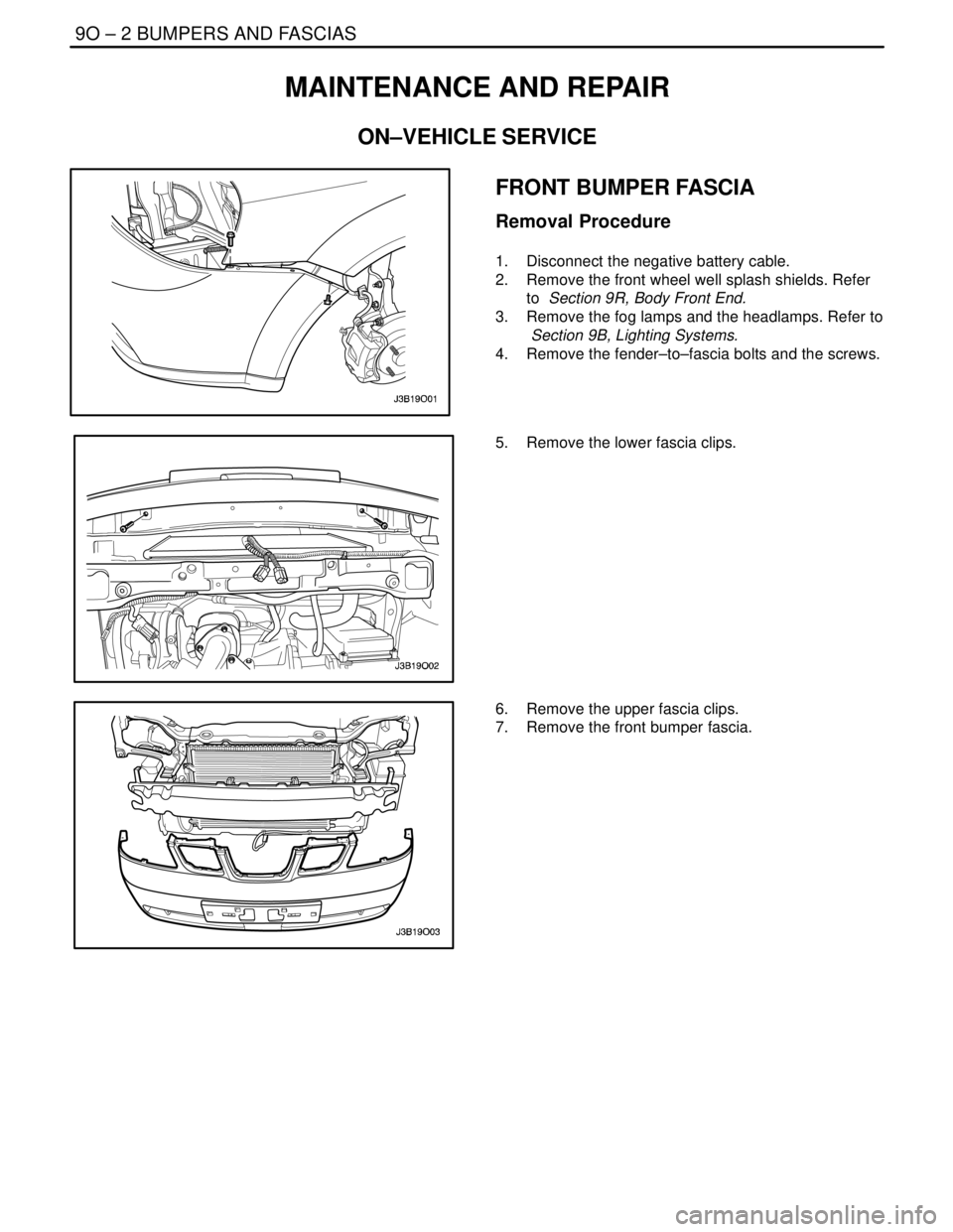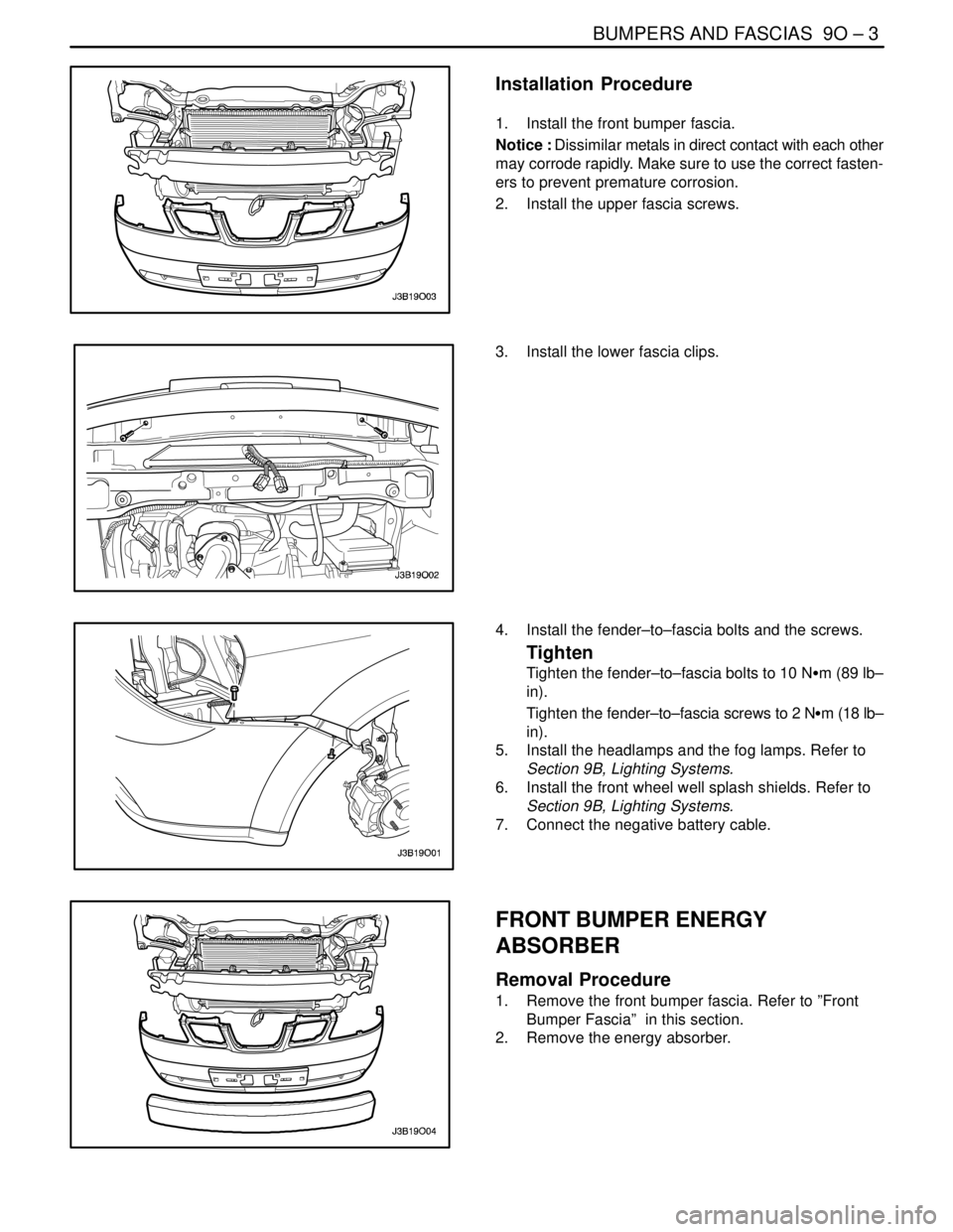2004 DAEWOO NUBIRA battery
[x] Cancel search: batteryPage 2413 of 2643

9O – 2IBUMPERS AND FASCIAS
DAEWOO V–121 BL4
MAINTENANCE AND REPAIR
ON–VEHICLE SERVICE
FRONT BUMPER FASCIA
Removal Procedure
1. Disconnect the negative battery cable.
2. Remove the front wheel well splash shields. Refer
to Section 9R, Body Front End.
3. Remove the fog lamps and the headlamps. Refer to
Section 9B, Lighting Systems.
4. Remove the fender–to–fascia bolts and the screws.
5. Remove the lower fascia clips.
6. Remove the upper fascia clips.
7. Remove the front bumper fascia.
Page 2414 of 2643

BUMPERS AND FASCIAS 9O – 3
DAEWOO V–121 BL4
Installation Procedure
1. Install the front bumper fascia.
Notice : Dissimilar metals in direct contact with each other
may corrode rapidly. Make sure to use the correct fasten-
ers to prevent premature corrosion.
2. Install the upper fascia screws.
3. Install the lower fascia clips.
4. Install the fender–to–fascia bolts and the screws.
Tighten
Tighten the fender–to–fascia bolts to 10 NSm (89 lb–
in).
Tighten the fender–to–fascia screws to 2 NSm (18 lb–
in).
5. Install the headlamps and the fog lamps. Refer to
Section 9B, Lighting Systems.
6. Install the front wheel well splash shields. Refer to
Section 9B, Lighting Systems.
7. Connect the negative battery cable.
FRONT BUMPER ENERGY
ABSORBER
Removal Procedure
1. Remove the front bumper fascia. Refer to ”Front
Bumper Fascia” in this section.
2. Remove the energy absorber.
Page 2421 of 2643

SECTION : 9P
DOORS
CAUTION : Disconnect the negative battery cable before removing or installing any electrical unit or when a tool
or equipment could easily come in contact with exposed electrical terminals. Disconnecting this cable will help
prevent personal injury and damage to the vehicle. The ignition must also be in LOCK unless otherwise noted.
TABLE OF CONTENTS
SPECIFICATIONS9P–2 . . . . . . . . . . . . . . . . . . . . . . . . . .
Fastener Tightening Specification 9P–2. . . . . . . . . . . . .
SCHEMATIC AND ROUTING DIAGRAMS9P–3 . . . . .
Power Door Locks Circuit 9P–3. . . . . . . . . . . . . . . . . . . .
Power Windows Circuit (Front Only) 9P–4. . . . . . . . . .
Power Windows Circuit (Front and Rear) 9P–5. . . . . .
DIAGNOSIS9P–6 . . . . . . . . . . . . . . . . . . . . . . . . . . . . . . . .
Power Windows 9P–6. . . . . . . . . . . . . . . . . . . . . . . . . . . .
MAINTENANCE AND REPAIR9P–16 . . . . . . . . . . . . . .
ON–VEHICLE SERVICE 9P–16. . . . . . . . . . . . . . . . . . . .
Outside Channel Molding 9P–16. . . . . . . . . . . . . . . . . . .
Front Door Glass Run 9P–16. . . . . . . . . . . . . . . . . . . . . .
Door Weatherstrip 9P–17. . . . . . . . . . . . . . . . . . . . . . . . .
Rear Door Glass Run 9P–18. . . . . . . . . . . . . . . . . . . . . .
Front Door Secondary Weatherstrip 9P–18. . . . . . . . . .
Rear Door Secondary Weatherstrip 9P–19. . . . . . . . . .
Front Door Opening Weatherstrip 9P–19. . . . . . . . . . . .
Rear Door Opening Weatherstrip 9P–20. . . . . . . . . . . . Door Seal Trim 9P–20. . . . . . . . . . . . . . . . . . . . . . . . . . . .
Door Lock Striker 9P–21. . . . . . . . . . . . . . . . . . . . . . . . . .
Door Lock Striker Adjustment 9P–22. . . . . . . . . . . . . . .
Front Door Lock 9P–23. . . . . . . . . . . . . . . . . . . . . . . . . . .
Childproof Rear Door Lock 9P–23. . . . . . . . . . . . . . . . . .
Inside Door Handle 9P–24. . . . . . . . . . . . . . . . . . . . . . . .
Outside Door Handle 9P–24. . . . . . . . . . . . . . . . . . . . . . .
Inside Lock Rod 9P–25. . . . . . . . . . . . . . . . . . . . . . . . . . .
Door Lock Cylinder 9P–25. . . . . . . . . . . . . . . . . . . . . . . .
Power Window Regulator 9P–26. . . . . . . . . . . . . . . . . . .
Door Assembly 9P–26. . . . . . . . . . . . . . . . . . . . . . . . . . . .
Door Hinge 9P–27. . . . . . . . . . . . . . . . . . . . . . . . . . . . . . .
Door Hold–Open Link 9P–28. . . . . . . . . . . . . . . . . . . . . .
GENERAL DESCRIPTION AND SYSTEM
OPERATION9P–29 . . . . . . . . . . . . . . . . . . . . . . . . . . . . .
Door Lock Striker 9P–29. . . . . . . . . . . . . . . . . . . . . . . . . .
Childproof Rear Door Lock 9P–29. . . . . . . . . . . . . . . . . .
Power Door Locks 9P–29. . . . . . . . . . . . . . . . . . . . . . . . .
Power Windows 9P–29. . . . . . . . . . . . . . . . . . . . . . . . . . .
Page 2426 of 2643

9P – 6IDOORS
DAEWOO V–121 BL4
DIAGNOSIS
POWER WINDOWS
System With Only Front Power Windows, One or Both Windows
are Inoperative
CAUTION : When powering the window motors directly from a battery with jumper wires, make sure one of the
jumper wires contains a fuse. If the jumpers are accidentally touched together, the fuse will prevent sparking
and burns from sudden terminal heating.
Step
ActionValue(s)YesNo
11. Turn the ignition ON.
2. Attempt to operate both power windows.
Is either window working?–Go to
Step 18Go to
Step 2
2Visually inspect the connection at the dual
power window switch.
Is the electrical connector correctly attached
to the switch?–Go to
Step 4Go to
Step 3
3Correctly attach the electrical connector to
the dual power window switch.
Is the repair complete?–System
OK–
41. Disconnect the electrical connector from the
dual power window switch.
2. Turn the ignition ON.
3. Check the voltage at terminal 4 and 5 of the
power window main switch connector.
Is the voltage equal to the specified value?11–14 vGo to
Step 16Go to
Step 5
5Check fuses EF14 and EF9.
Is either fuse blown?–Go to
Step 6Go to
Step 7
61. Check for a short circuit and repair if neces-
sary.
2. Replace the blown fuse(s).
Is the repair complete?–System
OK–
71. Turn the ignition ON.
2. Check the voltages at fuses EF9 and EF14.
Are both voltages equal to the specified val-
ue?11–14 vGo to
Step 9Go to
Step 8
8Repair the power supply to the fuse which did
not indicate battery voltage with the ignition
on.
Is the repair complete?–System
OK–
91. Remove the power window relay.
2. Turn the ignition ON.
3. Check the voltage at terminal 30 and terminal
85 of the power window relay socket. (Termi-
nals of the relay socket can be identified by
the markings on the bottom of the relay.)
Does the voltmeter indicate the specified val-
ue at terminals 30 and 85?11–14 vGo to
Step 11Go to
Step 10
10Repair the open circuit between the fuses and
the power window relay.
Is the repair complete?–System
OK–
Page 2428 of 2643

9P – 8IDOORS
DAEWOO V–121 BL4
StepNo Yes Value(s) Action
181. Remove the trim panel from a door which
has an inoperative power window.
2. Move a vehicle battery close enough to the
door so that the window motor can be pow-
ered directly from the battery with jumper
wires.
3. Disconnect the the two–pin window motor
connector in the door.
Important : To prevent the fuse in the jumper wire
from blowing, do not touch the jumper wires togeth-
er.
1. Attach a jumper wire between the battery
negative terminal and one of the terminals in
the two–pin window motor connector.
2. Attach a fused jumper wire between the bat-
tery positive terminal and the remaining ter-
minal in the two–pin window motor connec-
tor. Unless the motor is at the end of its trav-
el, the window should move with the jumpers
attached.
3. To move the window in the opposite direc-
tion, reverse the jumper wire connections at
the window motor connector.
Does the power window operate in both direc-
tions when the motor is operated directly from
a battery?–Go to
Step 20Go to
Step 19
19Replace the window motor.
Is the repair complete?–System
OK–
201. Before reconnecting the two–pin window mo-
tor connector, connect an ohmmeter between
the terminals to check the resistance of the
motor.
2. Record the ohmmeter reading for motor re-
sistance.
3. Reconnect the motor connector and reinstall
the door trim panel.
4. Disconnect the electrical connector from the
dual power window switch.
5. At the dual power window switch connector,
use an ohmmeter to check the resistance
between the terminals which lead to the mo-
tor that was tested in Step 15
Is the resistance at the switch connector
approximately equal to the resistance that
was previously measured at the motor con-
nector?–Go to
Step 22Go to
Step 21
21Repair the open circuit between the window
motor and the window switch.
Is the repair complete?–System
OK–
22Replace the power window switch.
Is the repair complete?–System
OK–
Page 2429 of 2643

DOORS 9P – 9
DAEWOO V–121 BL4
System With Front and Rear Power Windows, One or Both Front
Windows are Inoperative
CAUTION : When powering the window motors directly from a battery with jumper wires, make sure one of the
jumper wires contains a fuse. If the jumpers are accidentally touched together, the fuse will prevent sparking
and burns from sudden terminal heating.
Step
ActionValue(s)YesNo
11. Turn the ignition ON.
2. Attempt to operate each front power window.
Is either window working?–Go to
Step 18Go to
Step 2
2Visually inspect the connection at the power
window main switch.
Is the electrical connector correctly attached
to the main switch?–Go to
Step 4Go to
Step 3
3Correctly attach the electrical connector to
the power window main switch.
Is the repair complete?–System
OK–
41. Disconnect the electrical connector from the
power window main switch.
2. Turn the ignition ON.
3. Check the voltage at terminal 3 and 10 of the
power window main switch connector.
Is the voltage equal to the specified value?11–14 vGo to
Step 16Go to
Step 5
5Check fuses EF14 and EF9.
Is either fuse blown?–Go to
Step 6Go to
Step 7
61. Check for a short circuit and repair, if neces-
sary.
2. Replace the blown fuse(s).
Is the repair complete?–System
OK–
71. Turn the ignition ON.
2. Check the voltages at fuses Ef9 and EF14.
Are both voltages equal to the specified val-
ue?11–14 vGo to
Step 9Go to
Step 8
8Repair the power supply to the fuse which did
not indicate battery voltage with the ignition
on.
Is the repair complete?–System
OK–
91. Remove the power window relay.
2. Turn the ignition ON.
3. Check the voltage at terminal 30 and terminal
86 of the power window relay socket. (Termi-
nals of the relay socket can be identified by
the markings on the bottom of the relay.)
Does the voltmeter indicate the specified val-
ue?11–14 vGo to
Step 11Go to
Step 10
10Repair the open circuit between the fuses and
the power window relay.
Is the repair complete?–System
OK–
Page 2431 of 2643

DOORS 9P – 11
DAEWOO V–121 BL4
StepNo Yes Value(s) Action
181. Remove the trim panel from the front door
which has an inoperative power window.
2. Move a vehicle battery close enough to the
door so that the window motor can be pow-
ered directly from the battery with jumper
wires.
3. Disconnect the the two–pin window motor
connector in the door.
Important : To prevent the fuse in the jumper wire
from blowing, do not touch the jumper wires togeth-
er.
1. Attach a jumper wire between the battery
negative terminal and one of the terminals in
the two–pin window motor connector.
2. Attach a fused jumper wire between the bat-
tery positive terminal and the remaining ter-
minal in the two–pin window motor connec-
tor. Unless the motor is at the end of its trav-
el, the window should move with the jumpers
attached.
3. To move the window in the opposite direc-
tion, reverse the jumper wire connections at
the window motor connector.
Does the power window operate in both direc-
tions when the motor is operated directly from
a battery?–Go to
Step 20Go to
Step 19
19Replace the window motor.
Is the repair complete?–System
OK–
201. Before reconnecting the two–pin window mo-
tor connector, connect an ohmmeter between
the terminals to check the resistance of the
motor.
2. Record the ohmmeter reading for motor re-
sistance.
3. Reconnect the motor connector and reinstall
the door trim panel.
4. Disconnect the electrical connector from the
power window switch.
5. At the power window main switch connector,
use an ohmmeter to check the resistance
between the terminals which lead to the mo-
tor that was tested in Step 15.
Is the resistance at the main switch connector
approximately equal to the resistance that
was previously measured at the motor con-
nector?–Go to
Step 22Go to
Step 21
21Repair the open circuit between the window
motor and the window switch.
Is the repair complete?–System
OK–
22Replace the power window switch.
Is the repair complete?–System
OK–
Page 2432 of 2643

9P – 12IDOORS
DAEWOO V–121 BL4
System With Front and Rear Power Windows, One or Both Rear
Windows are Inoperative
CAUTION : When powering the window motors directly from a battery with jumper wires, make sure one of the
jumper wires contains a fuse. If the jumpers are accidentally touched together, the fuse will prevent sparking
and burns from sudden terminal heating.
Step
ActionValue(s)YesNo
11. Turn the ignition ON.
2. Make sure that the window lock position has
not been selected on the power window main
switch.
Is either rear power window working?–Go to
Step 18Go to
Step 2
2Visually inspect the connection at the power
window main switch.
Is the electrical connector correctly attached
to the main switch?–Go to
Step 4Go to
Step 3
3Correctly attach the electrical connector to
the power window main switch.
Is the repair complete?–System
OK–
41. Disconnect the electrical connector from the
power window main switch.
2. Turn the ignition ON.
3. Check the voltage at terminal 3 and 10 of the
power window main switch connector.
Is the voltage equal to the specified value?11–14 vGo to
Step 16Go to
Step 5
5Check fuses EF9 and EF14.
Is either fuse blown?–Go to
Step 6Go to
Step 7
61. Check for a short circuit and repair, if neces-
sary.
2. Replace the blown fuse(s).
Is the repair complete?–System
OK–
71. Turn the ignition ON.
2. Check the voltages at fuses Ef9 and EF14.
Are both voltages equal to the specified val-
ue?11–14 vGo to
Step 9Go to
Step 8
8Repair the power supply to the fuse which did
not indicate battery voltage with the ignition
on.
Is the repair complete?–System
OK–
91. Turn the ignition ON.
2. Remove the power window relay.
3. Check the voltage at terminal 30 and terminal
86 of the power window relay socket. (Termi-
nals of the relay socket can be identified by
the markings on the bottom of the relay.)
Does the voltmeter indicate the specified val-
ue?11–14 vGo to
Step 11Go to
Step 10
10Repair the open circuit between the fuses and
the power window relay.
Is the repair complete?–System
OK–